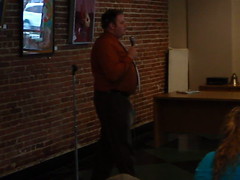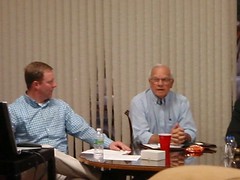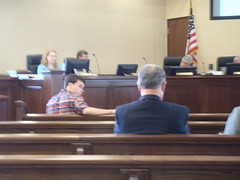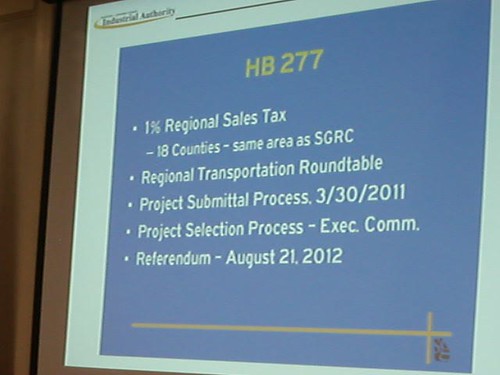 The 75% pot of T-SPLOST funds is what the project lists recently
submitted by Lowndes County
and the City of Valdosta are about,
according to
Corey Hull, continuing his presentation on T-SPLOST at the Lowndes County
Democratic Party (LCDP) meeting.
The 75% pot of T-SPLOST funds is what the project lists recently
submitted by Lowndes County
and the City of Valdosta are about,
according to
Corey Hull, continuing his presentation on T-SPLOST at the Lowndes County
Democratic Party (LCDP) meeting.
Those are projects of regional significance that the local jurisdictions want the voters to actually vote on that project.The other 25% goes to local jurisdictions, like this:
| $1,300,000 | Lowndes County (unincorporated portion) |
| $600,000 | Valdosta |
| $30,000 | Hahira |
| $5,000 | Dasher |
| $14,000 | Lake Park |
| $9,000 | Remerton |
Here’s the video:
Corey Hull of the Valdosta-Lowndes County Metropolitan Planning Organization (VLMPO)
explains T-SPLOST (HB 277) and the Transportation Investment Act of 2010
at the monthly meeting of the Lowndes County Democratic Party (LCDP),
Gretchen Quarterman (Chair), Valdosta, Lowndes County, Georgia.
Video by John S. Quarterman for LAKE, the Lowndes Area Knowledge Exchange.
Next: penalties if the voters don’t approve.
-jsq
You’ve heard Corey Hull of the Valdosta-Lowndes County Metropolitan Planning Organization (VLMPO)
give a brief version of T-SPLOST at VLCIA.
Here he talks at greater length at the
Lowndes County Democratic Party:
Back to the VDT editorial:
Continue reading
So you’ll have some idea what to expect, here’s
Corey Hull’s explanation of T-SPLOST to VLCIA in February.
You can come ask questions tonight!
-jsq
Corey Hull of the Valdosta-Lowndes County Metropolitan Planning Organization
(VLMPO)
explained T-SPLOST
at the regular monthly meeting,
Valdosta-Lowndes County Industrial Authority (VLCIA).
Georgia HB 277, which was passed by the legislature and signed into law
last year,
calls for a 1% regional sales tax (T-SPLOST) to fund
transportation projects.
The region including Lowndes County has 18 counties,
Continue reading
The Sierra Club letter he mentions
was posted last week.
For NOAA Weather Radios
see previous posts.
Here is
the video:
Here’s the list:
Continue reading
Here is
her comment from 15 March 2011 on this blog:
Anyone who wants to help still more,
you, too, can go to a meeting.
The Industrial Authority is a good one to attend,
but I hear the Tree Commission isn’t trying as hard to enforce things,
and does anybody know anything the Hospital Authority does?
The Airport Authority?
Continue reading
T-SPLOST Explained —Corey Hull of VLMPO at LCDP (Part 1)
So who are these regional commissions?
Continue reading  The Georgia legislature passed what was then known as House bill 277
called
Transportation Investment Act of 2010….
It created or proposed a one percent sales tax for transportation purposes
throughout the state of Georgia.
It creates
twelve special transportation taxing districts
that are based on the boundaries of the regional commissions.
And that is where the connection with the regional commission stops.
They are not the same body….
The Georgia legislature passed what was then known as House bill 277
called
Transportation Investment Act of 2010….
It created or proposed a one percent sales tax for transportation purposes
throughout the state of Georgia.
It creates
twelve special transportation taxing districts
that are based on the boundaries of the regional commissions.
And that is where the connection with the regional commission stops.
They are not the same body….
VDT says VLCIA illegally made up a document
Presumably that would be the “Project Critical Path time-line is attached”
that wasn’t actually attached to
documents returned for an open records request of 17 February 2011.
Hm, since VLCIA did supply such a document to the VDT,
presumably it is now a VLCIA document subject to open records request,
even though it was not what VLCIA told VDT it was.
 The reporter who conducted the interview with Industrial Authority Project
Manager Allen Ricketts has been subsequently repeatedly contacted by
Ricketts for what he deems “false reporting.” According to Ricketts,
the timeline was never official and was only something the Industrial
Authority threw together to appease the Times when given an official Open
Records Request. Ricketts is apparently unaware that legally he cannot
produce a document that does not exist to comply with said request. If
he knowingly did so, as he now claims, that is a clear violation of the
Open Records Act.
The reporter who conducted the interview with Industrial Authority Project
Manager Allen Ricketts has been subsequently repeatedly contacted by
Ricketts for what he deems “false reporting.” According to Ricketts,
the timeline was never official and was only something the Industrial
Authority threw together to appease the Times when given an official Open
Records Request. Ricketts is apparently unaware that legally he cannot
produce a document that does not exist to comply with said request. If
he knowingly did so, as he now claims, that is a clear violation of the
Open Records Act.
T-SPLOST explained by Corey Hull and Ashley Paulk, tonight, LCDP

Come hear Chairman Ashley Paulk and MPO Director Cory Hull give
us information about T-SPLOST. The special local option tax for
Transportation.
Ashley Paulk is Chairman of the Lowndes County Commission.
 Corey Hull is Coordinator for the
Valdosta-Lowndes County Metropolitan Planning Organization (VLMPO).
Corey Hull is Coordinator for the
Valdosta-Lowndes County Metropolitan Planning Organization (VLMPO).
 Here’s a very interesting
question by Norman Bennett at that same meeting.
Here’s a very interesting
question by Norman Bennett at that same meeting.
Explain about the penalties if the voters don’t pass T-SPLOST? –Norman Bennett
 Norman Bennett, VLCIA board member and former chairman of the Lowndes County Commmission,
asked Corey Hull:
Norman Bennett, VLCIA board member and former chairman of the Lowndes County Commmission,
asked Corey Hull:
Can you explain that again for me about the penalties if the voters don’t pass the tax?
If the county’s got a project, then they’ve got to put up ten percent
or whatever the percentage is?
Continue reading
Corey Hull explains T-SPLOST to VLCIA, 15 Feb 2011
 What’s this about yet another sales tax decided on by
regional transportation boards and GDOT?
What’s this about yet another sales tax decided on by
regional transportation boards and GDOT?
Just say no to biomass –VDT to VLCIA
Well, the City of Valdosta could
refuse to sell the wastewater.
And maybe the Lowndes County Commission could exercise its
fiduciary responsibility.
But, sure, the Industrial Authority could just say no.
 In two months, less than 60 days away, Wiregrass Power LLC is supposed to
break ground on the biomass facility in Lowndes County. By now, they are
supposed to have contracts with power companies to sell the electricity
to and with suppliers to purchase the wood waste. They have neither,
nor does the company have an agreement with the city of Valdosta to
purchase the wastewater from the sewage treatment plant.
In two months, less than 60 days away, Wiregrass Power LLC is supposed to
break ground on the biomass facility in Lowndes County. By now, they are
supposed to have contracts with power companies to sell the electricity
to and with suppliers to purchase the wood waste. They have neither,
nor does the company have an agreement with the city of Valdosta to
purchase the wastewater from the sewage treatment plant.
Folks?
Like Col. Ricketts?
But remember, he and
Lame-Duck Lofton
are only
Continue reading .jpg) And yet the folks at the Industrial Authority appear to be rather
nonchalant about the fact that this company has yet again broken its
agreement. They have the power to renogiate the terms of the agreement and
they also have the power to cancel it, but neither is happening. Instead,
they are giving the company all the leeway they need to continue dragging
this project along that the community doesn’t want.
And yet the folks at the Industrial Authority appear to be rather
nonchalant about the fact that this company has yet again broken its
agreement. They have the power to renogiate the terms of the agreement and
they also have the power to cancel it, but neither is happening. Instead,
they are giving the company all the leeway they need to continue dragging
this project along that the community doesn’t want.
What Are Our Priorities? –Dr. Noll @ LCC 22 March 2011
 Dr. Noll raised a number of issues about community priorities
at the Lowndes County Commission meeting of 22 March 2011
and asked what are our priorities?
Dr. Noll raised a number of issues about community priorities
at the Lowndes County Commission meeting of 22 March 2011
and asked what are our priorities?
Video by Gretchen Quarterman for LAKE, the Lowndes Area Knowledge Exchange.
VDT on LCC last night
 LAKE is thrilled when the VDT covers things so we don’t have to.
David S. Rodock in his writeup in VDT this morning on
yesterday’s Lowndes County Commission meeting
includes this list that was not displayed in the public meeting,
yet was approved by the commissioners.
Car 41 No where are you?
LAKE is thrilled when the VDT covers things so we don’t have to.
David S. Rodock in his writeup in VDT this morning on
yesterday’s Lowndes County Commission meeting
includes this list that was not displayed in the public meeting,
yet was approved by the commissioners.
Car 41 No where are you?
Communities watching boards
 don’t interact with their communities.
Well, paraphrasing what Yakov Smirnoff used to say,
in Lowndes County, community interact with officials!
don’t interact with their communities.
Well, paraphrasing what Yakov Smirnoff used to say,
in Lowndes County, community interact with officials!
Not to be rude, although honesty is very often perceived that way
these days, but, the industrial authority executives rarely thank their
communities. In the six states I’m most familiar with, these fellows
see themselves as beholden only to their employers. After all, they work
with their directors, elected officials, a few bankers and city/county
department heads. Rarely do they come in direct contact with the average
voter, employee or homeowner, although all those people often pay a large
part of their salaries and office operating expenses. Despite the public
funding, these groups are usually tight lipped about how they do business
and rarely provide the public with records or audits. We’ve all put up
with that manner of doing business for so long we now see it as just
that — the way you do business. We’d never accept that from a nonprofit
organization, a charity group or most elected officials. Shame on us all.
Susan, you’re helping by reading, and you’re helping more by posting.
Many local officials have noticed LAKE and this blog because
they know people read it.
